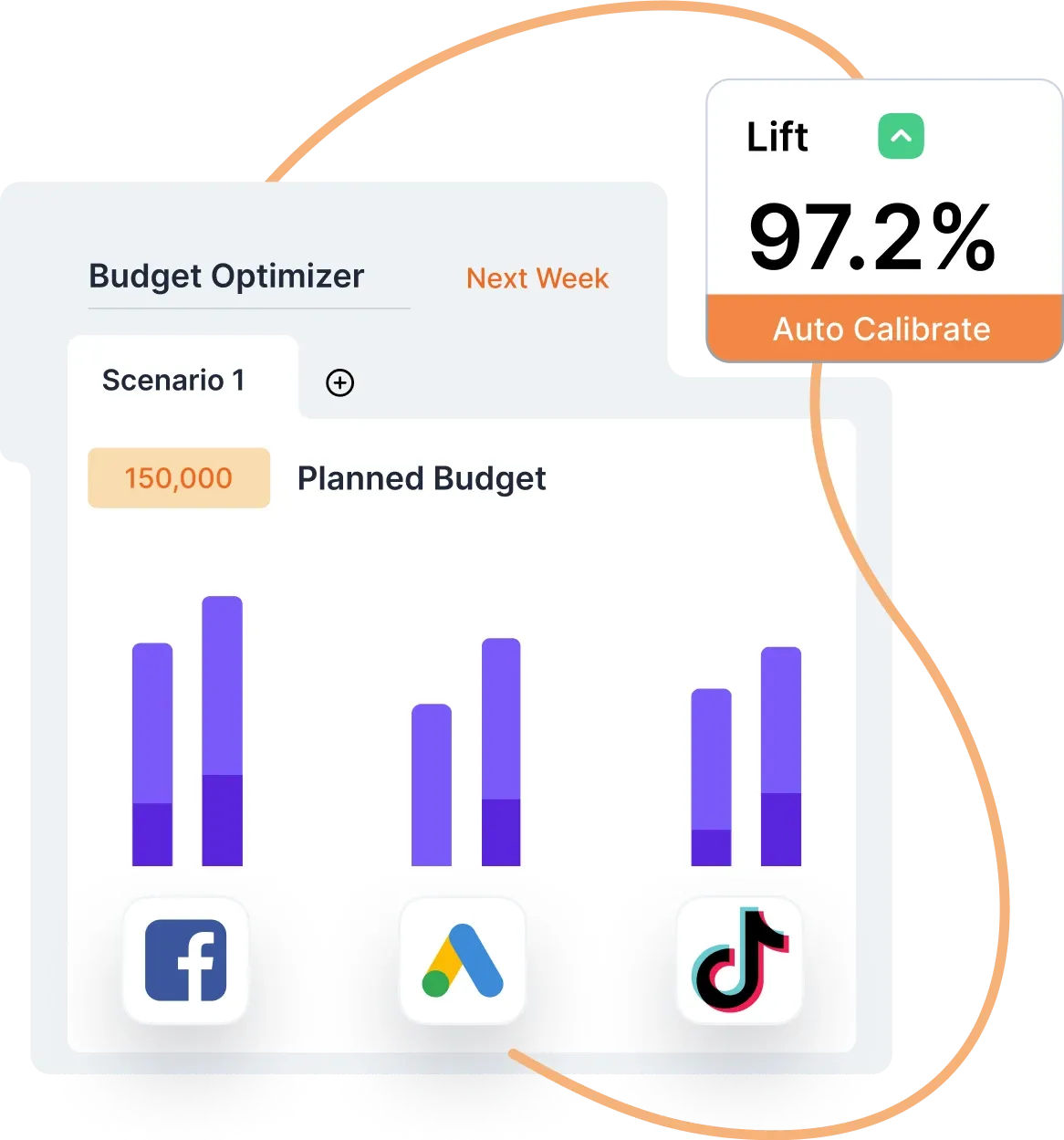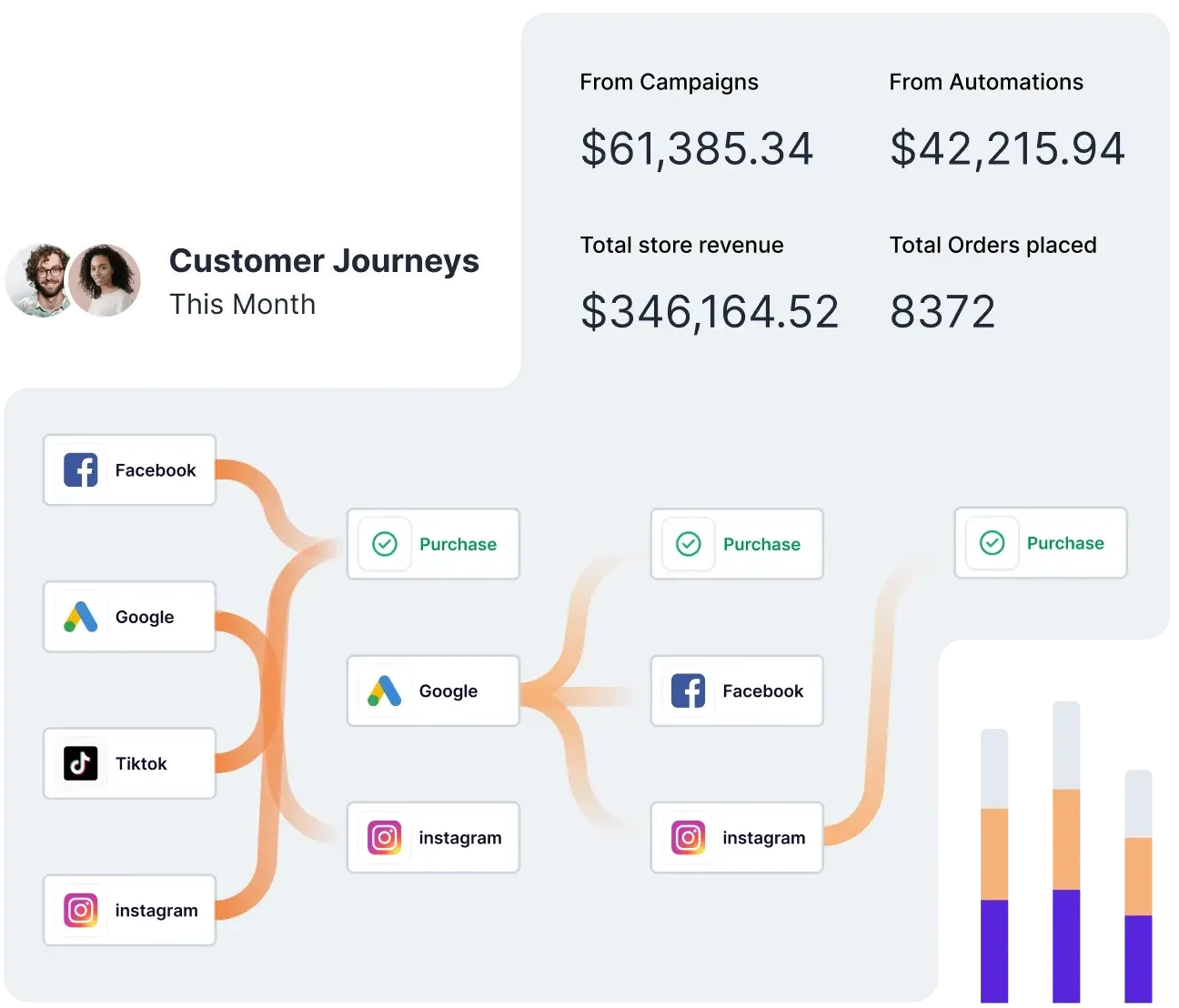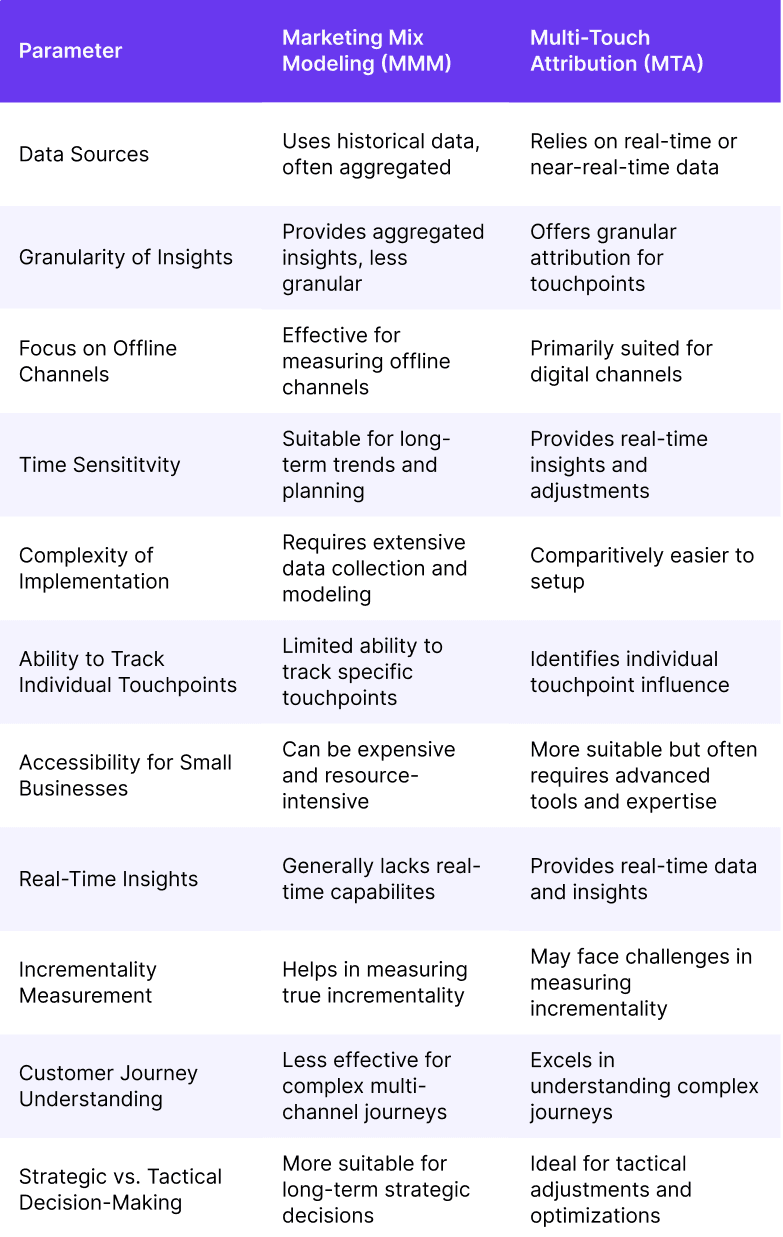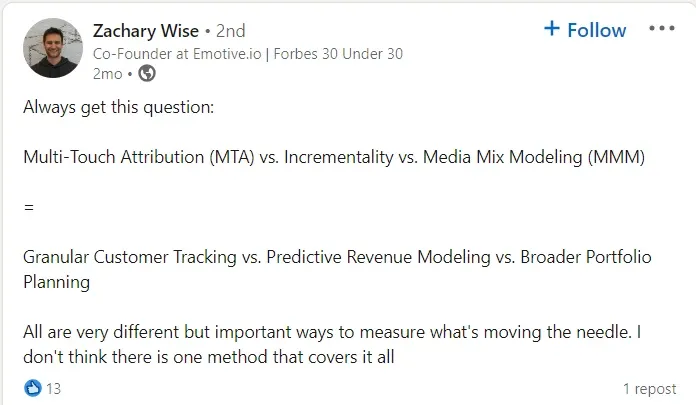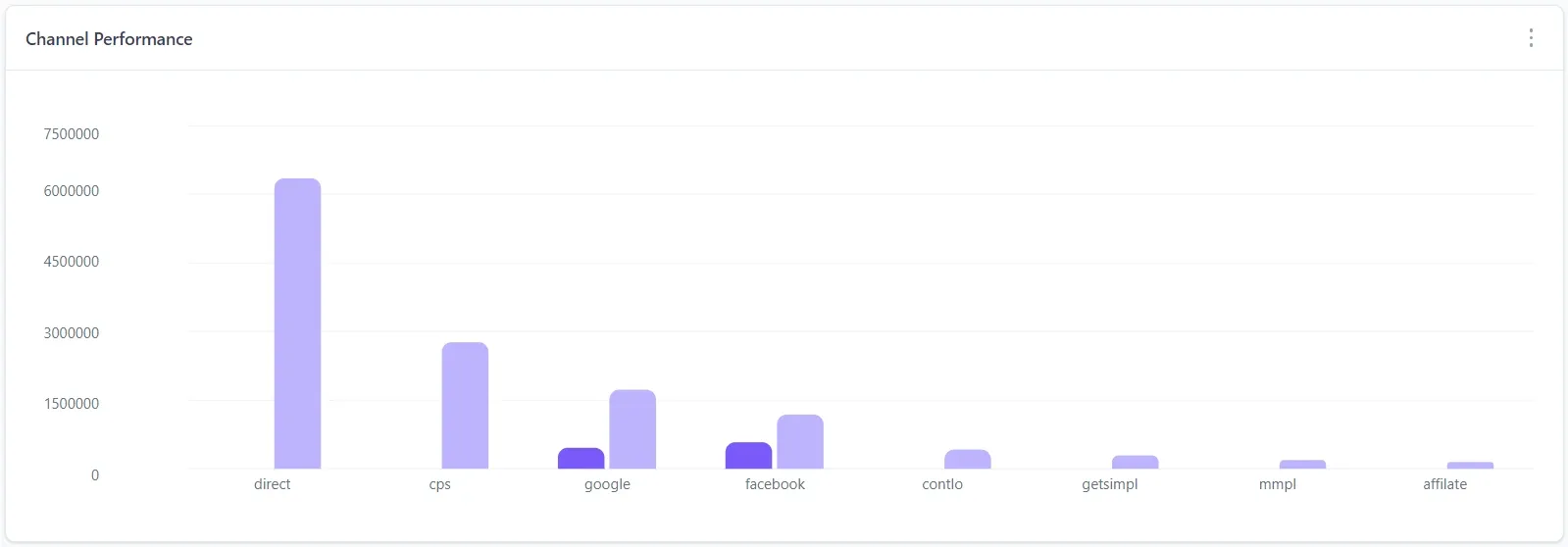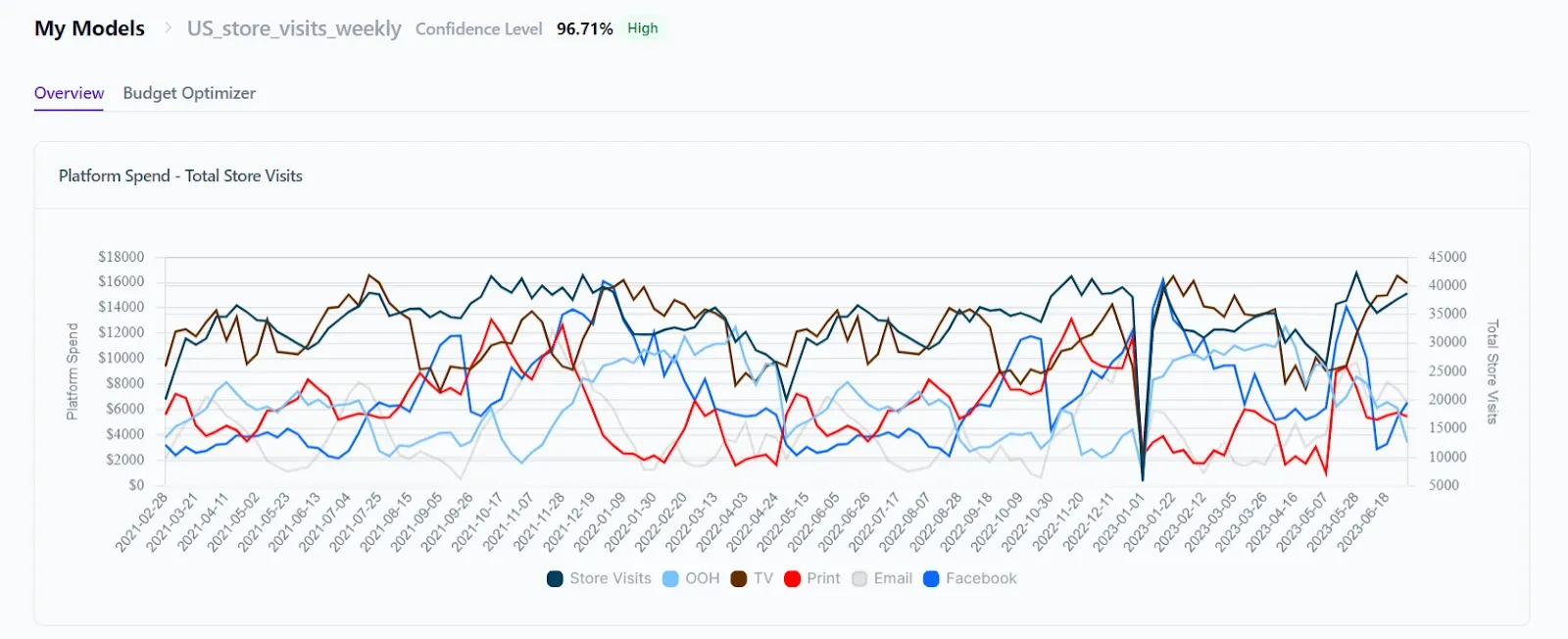MMM and MTA are two of the most popular marketing measurement models. But which one is right for you? This blog post compares the two models and helps you decide which one to use to improve your marketing results.
If you break down marketing into its bare components, you will understand that it is basically composed of two things:
- Creative: How you communicate the message you want to deliver to your prospects
- Data: How do you measure the success of the creative
The creative front is usually led by how you want to portray your brand, and there is no right or wrong way here. However, the data side of things is something that everybody knows is crucial, but only some marketers follow the data and the story.
When you roll out a marketing campaign, how exactly do you measure its success? Is it the impressions it gets you, the traffic you get to your store/website, or the revenue it makes for your business?
More often than not, it’s a combination of all these and more.
Humans are highly impressionable beings who are constantly bombarded with information from various sources, and brands are one too. As a brand, sending this information is not always free of cost. It will cost you some dollars, irrespective of whether you are doing it organically or taking the paid route.
Spending money on marketing is a superpower. Don’t believe us? Ask the small business owner who is walking the tightrope of gett-ing customers by spending nothing or the least. While you may be a bigger brand with more money in the bank, would you really want to spend all your money on different marketing channels without understanding how exactly your investment is giving you returns?
No? We figured that out.
So, how do you measure the success of your marketing campaigns?
If you whispered attribution to yourself, you are right. However, attribution is a reactive way to measure marketing. And as you have heard about the favorite proverb of mothers and doctors – “Prevention is better than cure”, you will know that proactive measures are always better.
Is it though?
In this blog post, we will be comparing two marketing measurement approaches
1. The reactive one in the form of Multi-Touch Attribution
2. The proactive one in the form of Marketing Mix Modeling
Before you tell us you know the winner, hold on and read the blog to be surprised by the results.
Let’s start with Marketing Mix Modeling
What is Marketing Mix Modeling or MMM?
Marketing Mix Modeling, or MMM, also known as Marketing Mix Analysis or simply Mix Modeling, is a powerful analytical technique used by businesses to evaluate the impact of various marketing tactics on their overall sales and revenue. It’s a data-driven approach that provides insights into how different marketing elements contribute to a company’s performance.
Simple depiction of an MMM model
A simple depiction of an MMM model analyzing different marketing channels and predicting the incremental revenue from these channels
For instance, if you are distributing your spend across multiple marketing channels – Facebook, Google, TikTok, ABM, banner ads, print, and television, MMM can help you get a clear understanding of how much ROI you are getting for the investment in each of these channels.
“MMM is particularly valuable for understanding the effectiveness of both online and offline marketing efforts.”
But how does MMM work?
We get it; MMM might seem to be a crystal ball telling you what channels will give you the best results. But as much as we want you to believe that, it is not a crystal ball.
It is a statistical system that feeds on historical data related to your marketing activities and sales performance and gives you a map of how every channel contributed to the overall revenue generated.
To help you get a better understanding of the workings of MMM, here’s a breakdown of the entire process:
1) Data Collection :
The first step involves gathering data on various marketing inputs and outcomes. This data includes information on advertising spend, promotional activities, pricing strategies, market conditions, and sales figures.
2) Data Analysis :
Once the data is collected, it’s analyzed to identify patterns and relationships. Statistical techniques are used to quantify the impact of each marketing element on sales. This analysis aims to answer questions like. “How does a 10% increase in advertising spending affect sales?”
3) Model Development :
Mathematical models are constructed to represent the relationships identified in the data analysis. These models typically involve multiple variables and equations to simulate how changes in marketing variables influence sales.
4) Simulation and Optimization :
With the models in place, marketers can simulate various scenarios to understand how changes in marketing strategies might impact future sales. This helps in optimizing marketing budgets and resource allocation.
5) Validation and Refinement :
The models are continually validated and refined to ensure accuracy and relevance. As new data becomes available, the models are updated to reflect changing market conditions.
Here’s Shubham Jain, our MMM expert, to help you get a better understanding of how this entire system works for a brand:
Pros and cons of MMM
Like any solution MMM is not perfect, it has its advantages and disadvantages.
Pros of MMM:
1) Data-Driven Insights : MMM relies on historical data, making it a reliable method for understanding the impact of marketing efforts.
2) Holistic View : It considers various marketing channels and activities, providing a comprehensive understanding of their effectiveness.
3) Long-Term Analysis : MMM can assess the long-term impact of marketing strategies, helping marketing teams make informed decisions for the future.
4) Budget Optimization : It assists in optimizing marketing budgets by identifying which channels deliver the best ROI.
5) Offline Channel Integration : It can effectively measure the impact of traditional offline marketing channels like TV, radio, and print, which can be challenging for MTA.
Cons of MMM:
1) Lack of Granularity : MMM tends to provide aggregated insights, lacking granularity compared to MTA. It may not distinguish between individual touchpoints in the customer journey.
2) Complexity : Building and maintaining MMM models can be complex and time-consuming. You can however alleviate this by using a vendor-provided solution.
For your interest: Learn more about how to choose the right MMM vendor
3) Data Quality : The accuracy of MMM results heavily depends on the quality of the input data. If you screw up the data, the output generated might do more harm than good to your business.
4) Expensive : Implementing MMM can be costly, especially for smaller businesses
5) Limited Real-Time Insights : MMM often relies on historical data, which may fail to accurately anticipate external events that might derail your marketing efforts.
When to use MMM?
Alright, so you have understood the A-Z of MMM and want to start using it in your business. But have you thought of when exactly you need a solution like MMM?
If not, here are some scenarios where MMM can be highly beneficial for your business:
1) Cross-Channel Marketing :
When you have multiple marketing channels (e.g., TV, digital, print) and want to understand their individual and combined impact.
2) Long-Term Strategy :
If you’re interested in assessing the effectiveness of marketing efforts over extended periods, such as quarterly or annually.
3) Budget Allocation :
When you need to allocate your marketing budget effectively to maximize ROI(hint: BFCM quarter)
4) Product Launch or Rebranding :
When launching a new product or rebranding, MMM can help you assess the impact of these changes on sales
5) Competitive Analysis :
To understand how your marketing efforts compare to those of competitors
Now you know everything about MMM and might possibly think this is the best strategy for marketing success. Why would you even need a reactive approach like MTA?
Well, we suggest you don’t rush and instead get to know about MTA and then make the decision
Everything about Multi-Touch Attribution
What is Multi-Touch Attribution or MTA?
Multi-Touch Attribution, or MTA, also referred to as Marketing Attribution, is a sophisticated measurement model that has increasingly gained traction over the last few years, especially since iOS 14. It’s basically a more nuanced approach that analyzes your customer’s journey to identify and credit the different touchpoints they come across during their engagement with your brand.
Multi-Touch Attribution model of Lifesight
The Multi-Touch Attribution model of Lifesight shows a customer’s journey and the different touchpoints they engage with!
For example, if you run an e-commerce store and use multiple marketing channels, then MTA can help you identify all of these touchpoints where your customer interacts with your brand, and based on the attribution model, it assigns credit to all the touchpoints effectively.
How does MTA work?
MTA works by analyzing and assigning value to multiple touchpoints along the customer journey. It recognizes that a typical customer interacts with a brand through various channels before making a purchase or taking a desired action. These touchpoints can include social media ads, email campaigns, website visits, and more.
The MTA model uses advanced algorithms and data-driven methodologies to distribute credit among these touchpoints based on their influence on the conversion. It takes into account the sequence and timing of these interactions, attributing varying levels of importance to each touchpoint. This holistic approach provides a more accurate representation of how different marketing efforts contribute to overall success.
There are multiple attribution models available, each offering a different perspective on how credit should be distributed. Here are some of them:
1) First-Touch Attribution :
Gives full credit to the first touchpoint a user interacts with. It’s great for understanding how initial brand awareness is generated.
2) Last-Touch Attribution :
Attributes all credit to the last touchpoint before conversion. It’s useful for identifying the final trigger that led to a conversion.
3) Linear Attribution :
Distributes credit equally among all touchpoints in the customer journey. This provides a more balanced view of the customer’s path.
4) Time Decay Attribution :
Assigns more credit to touchpoints closer to the conversion event, acknowledging the diminishing influence of earlier interactions.
5) Position-Based Attribution :
Also known as the U-shaped model, this assigns more credit to the first and last touchpoints and less to the middle ones, recognizing the roles of both introduction and closure.
6) Algorithmic Attribution :
Utilizes machine learning and statistical models to determine the credit for each touchpoint based on historical data and patterns.
7) Custom Attribution :
This allows businesses to create their own attribution models tailored to their specific needs and goals.
Different kinds of attribution models
Different kinds of attribution models and how they work
Pros and Cons of MTA
MTA might come across as a simpler model compared to MMM, however, simplicity is not what you look for when you are a large business. As Monish rightly mentions in his tweet, MTA makes you ask better questions.
Monish mentions in his tweet on MTA
Monish, Ads Product Lead at TikTok US, is sharing one of the core reasons why MTA is necessary
Having said that, MTA brings its own advantages and disadvantages.
Pros of MTA:
1) Granular Attribution :MTA provides granular attribution, offering insights into the specific touchpoints that contribute to conversions. This granularity can guide tactical decision-making.
2) Real-Time Insights : MTA can offer real-time data and insights, allowing marketers to make quick adjustments to their campaigns and strategies
3) Digital Focus : MTA is especially well-suited for digital marketing channels, where customer interactions are easily trackable and immediate.
4) Customer Journey Understanding : MTA excels in understanding complex, multi-channel customer journeys, which are prevalent in the digital age.
Cons of MTA:
1) Channel Limitation : MTA may struggle to measure the impact of offline channels effectively, which can be a limitation to businesses with a significant offline presence.
2) Data Challenges : Like MMM, MTA too heavily relies on accurate and complete data, and discrepancies or gaps in data can lead to inaccurate attribution.
3) Complexity : MTA can be complex to set up and requires advanced analytics tools and expertise, making it less accessible for some organizations. However, it’s not as complex as setting up an MMM solution
4) Incrementality : MTA sometimes faces challenges in measuring the true incrementality of marketing efforts, as it attributes value to touchpoints without considering the counterfactual scenario (what would have happened without those touchpoints).
When to use MTA
We believe you will always have to measure the impact of your marketing efforts and MTA is the simpler way to do that. However, we want to uncover some instances where MTA can really shine for your business. Here are some:
1) Multi-Channel Strategy :
Your marketing strategy involves multiple channels, and you need to understand how each contributes to conversions.
2) Long Sales Cycles :
You have a lengthy sales cycle with multiple touchpoints over time and want to optimize each stage.
3) Complex Customer Journeys :
Your customers engage with your brand through various touchpoints before converting, making it challenging to determine the most influential ones.
4) Continuous Improvement :
You are committed to continuously refining your marketing strategies and are willing to invest in advanced attribution modeling.
MMM vs. MTA Summarized
Before we jump to which is the better marketing measurement solution, here’s a summary of the comparison of MMM and MTA
Table comparing MMM and MTA 1
A table comparing MMM and MTA on different parameters
So, Who wins? MMM or MTA?
Long story short, both MMM and MTA are equally important for a business.
The right question to ask here is how to ensure you can get the best of both technologies.
Let us explain.
While MMM and MTA offer unique perspectives on marketing effectiveness, they are not mutually exclusive. In fact, they can complement each other exceptionally well. When used together, these methodologies create a synergistic approach to marketing analytics that helps businesses get the best of both worlds.
Zachary Wise explains on MTA & MMM
Zachary Wise, co-founder of emotive.io explains how MTA, MMM and IT form the trifecta to help you measure marketing success. Source
To help you understand how exactly you can leverage the best of both MMM and MTA, here’s a use case.
Use Case: Enhancing the Digital Marketing Strategy for an Ecommerce Brand using Lifesight
Consider a hypothetical ecommerce brand which sells a wide range of apparel. They have been using MTA to track customer interactions with their digital marketing campaigns, primarily focusing on channels like paid search, social media ads, and email marketing. While MTA has been instrumental in optimizing these digital channels, the brand is also looking to refine its overall marketing strategy, including offline efforts and long-term planning. This is where Marketing Mix Modeling (MMM) comes into play.
To help you get a deeper understanding, we will be using our measurement module which has both MTA and MMM ingrained into a single platform.
As a first step, we used MTA to get real-time insights and tactical decision-making in the apparel digital marketing campaigns. As shown in the image, the platform reveals that its Google ad campaign has been driving a significant number of click-throughs and conversions, indicating its effectiveness in the short term. However, there is a significant revenue attributed to “direct” traffic.
Lifesight’s Platform showcasing how MTA works
Randomized data was taken on Lifesight’s Platform to showcase how MTA can help you identify the touchpoints that are effective in your marketing
To get a deeper understanding of what’s happening in marketing, we decided to complement their MTA approach with MMM. We collected historical data on various marketing channels, including offline initiatives like TV advertising and in-store promotions. We also factored in external variables such as economic conditions and seasonal trends.
Since we had all this data in an Excel sheet, we could easily upload it onto the platform to see how every activity led to a store visit.
This is the result we got from the data we uploaded onto the platform:
Lifesight’s MMM shows how different offline channels Work
Lifesight’s MMM shows how different offline channels Work.
Lifesight’s MMM shows how different offline channels led to impressions and store visits for the apparel brand
Based on this analysis, we discovered some key insights for apparel brand:
1. As seen from the image below, there is a high correlation between TV ads and store visits, thus giving a clear idea of how brand’s investment in TV is working out
Lifesight’s MMM model shows a correlation between TV ads and store visits
Lifesight’s MMM model shows a correlation between TV ads and store visits
2. Though there is a significant investment in email, OOH and Facebook, the returns are not good enough.
ROI of email, OOH and Facebook have not been up to the mark as seen on the Lifesight Platform
ROI of email, OOH and Facebook have not been up to the mark as seen on the Lifesight Platform
Based on these findings, the apparel brand can now focus more on using TV and Print to raise awareness while adding more budget to their Google Ads. And since other channels, have not been performing as per expectations, they can reduce their budget
The Result?
Well, using both MMM and MTA together, the brand could:
- Achieve a more comprehensive understanding of their marketing ecosystem, with insights into both online and offline channels
- Get better alignment of their marketing strategy with long-term brand building and seasonal trends
- Improve allocation of resources, ensuring that budget is allocated to initiatives with the highest ROI
- Enhance their attribution accuracy, providing a clearer picture of the customer journey and the influence of various touchpoints.
Summing it all up
Now, the million-dollar question: which model should you choose? Well, here’s the important insight: you don’t have to choose just one. In fact, the most effective approach often involves using both MMM and MTA in tandem.
Why? Because they complement each other beautifully. MMM provides the big-picture, strategic insights that can inform long-term planning and budget allocation, while MTA offers the real-time, granular data necessary for tactical decision-making and optimization.
So, the answer isn’t MMM OR MTA; it’s MMM AND MTA. By embracing both models, you’ll have a comprehensive toolkit for understanding and optimizing your marketing efforts.
Unlocking the Power of Measurement Solutions
To truly supercharge your marketing measurement, consider the Lifesight Unified Marketing Measurement platform that provides a comprehensive suite of measurement solutions, including MTA, MMM, and Incrementality Testing. These tools can empower your business to gain a deeper understanding of your marketing ecosystem, optimize your strategies, and maximize your chances of success.
Sign up for a demo with Lifesight today and discover how our cutting-edge measurement solutions can help you achieve your marketing goals with precision and confidence.
You may also like
Essential resources for your success

